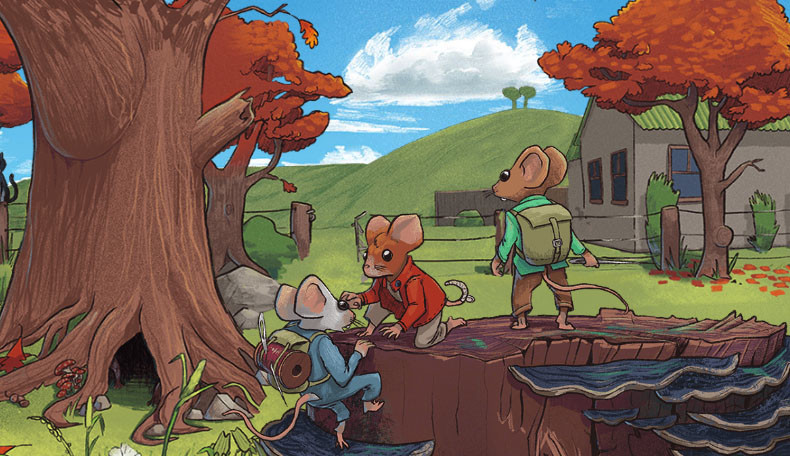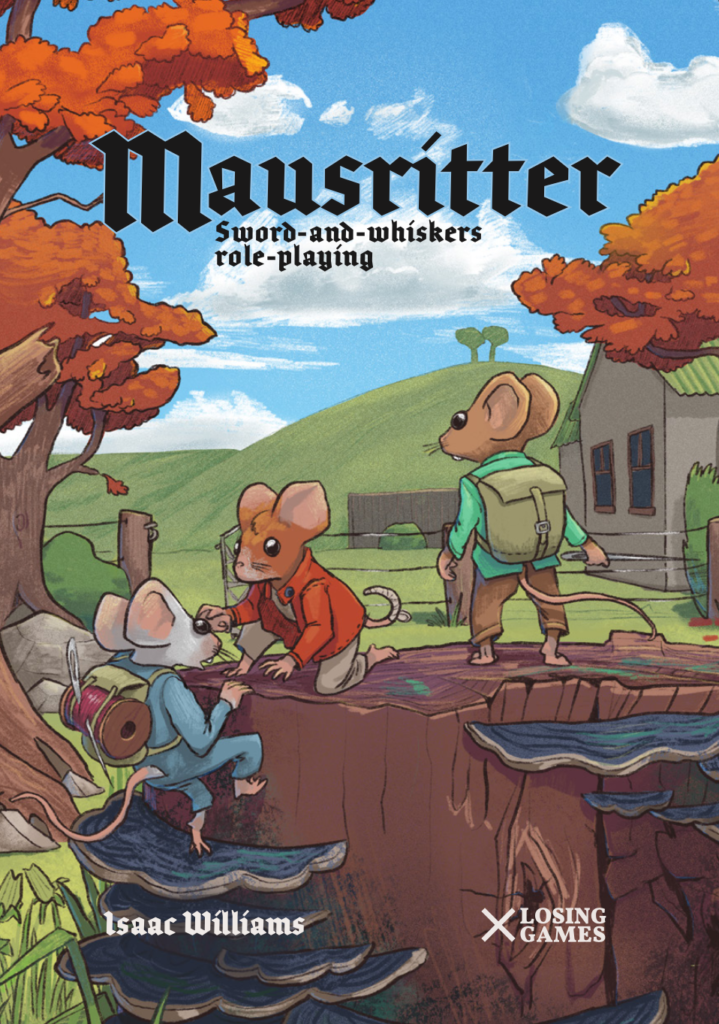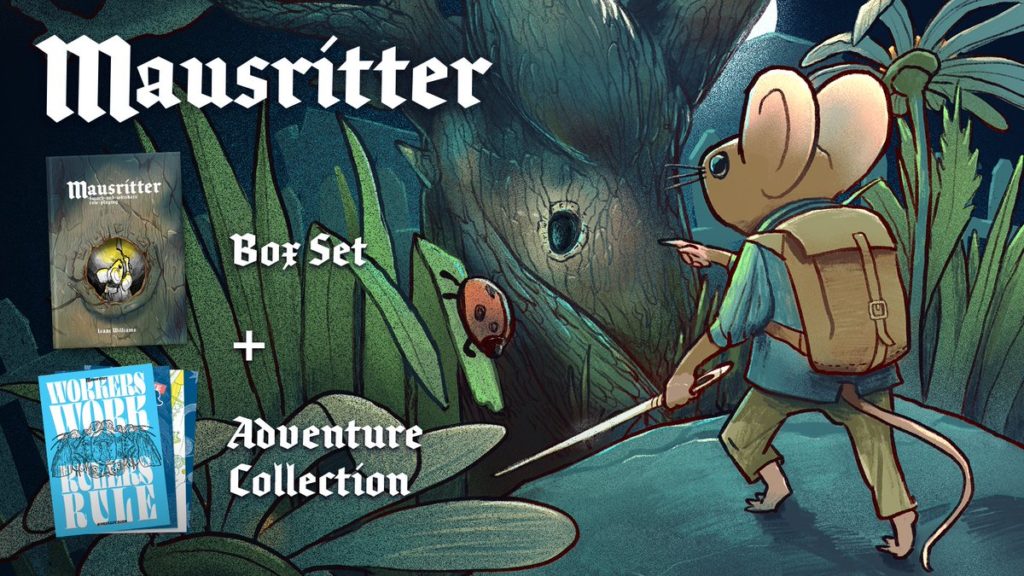Review of Mausritter

After the writing about a little funny game around loot which sparks joy, I want to talk about Mausritter, today. Actually, it’s not a pure reading review, as I’ve been playing the game regularly since January 2021 and now have a good 10 sessions with a wide variety of people behind me. Nevertheless, we’ll start here with an insight of the text, the rules and what Mausritter actually wants to give us.
Further on, I won’t go into all the rules, so there are still random encounters and such, which have to be taken into account when exploring. Nevertheless, we want to achieve an all-around, to show the core features of this small but wonderful game.

- Publisher: Losing Games
- Release Date: 2019 / 2020
- Language: English
- Pages: 48
- Format: PDF / Print
- Price: Pay What you want as PDF on itch.io / 20 € for Hardcover at Games Omnivorous
What is Mausritter about?
In Mausritter the players take on the role of little knights in a large and dangerous world. In Mausritter, magic is dangerous, beasts are powerful and the lands are wondrous. We are in a sword and whisker world, although the appearance of the people can change from setting to setting. For Mausritter comes with no fixed setting, but a rich toolbox for hexcrawling. As an example, it comes with an adventure and hexcrawl to show how anyone can use the tools to develop their own adventure. For example, some members of the community create garbage dumps, trees, or entire forests as the world of their campaign.
Since Mausritter is a newer OSR game, we get by with few rules, but have something pre-made for many different areas. The rules are based on Into the Odd. Still they are expanded with cards for items, an inventory system limited with slots, and individual rules for recharging spells. Otherwise, each mouse has three attributes: strength, dexterity, and willpower. Since the maximum value of an attribute at the start can only be 12, but saves are rolled with a d20, approaches that do not require a dice roll are preferred. In combat, you always hit and roll your damage directly, making fights quick and deadly. Caution rather than indulgence is the order of the day for the little brave mice!
Character Progression
Character creation works quickly and simply in this wonderful role-playing game. For each attribute, you roll 3d6 in order and keep the highest two values. After that, you may swap two values with each other. After that, you roll a dice to determine the hit protection (HP).
Excursus: Hit protection
This is so that when the mouse suffers damage points, the HP are reduced first. If the HP are used up, the mouse suffers damage to the attribute values. If the strength reaches the value 0, the mouse is dead. If Dexterity reaches 0, the mouse is immobilized, and if Willpower reaches 0, the mouse is insane. A rest heals HP or attribute values again. There are short, long and full rests.
You then roll a d6 for the pips, which is a currency in the mouse realms. Starting money and hit protection then add up to the mouse’s background on a d66 table. The background also gives the starting equipment, because you start with torches, rations, an item of the background and a weapon of your choice.
Last but not least, roll the dice for the mouse’s appearance. A d6 for the birthmark, d6 for the fur color and d6 for the pattern in the fur. On a d66 table you then roll a special feature like an eye patch. If you can’t come up with a name, you can also roll on a table for the first and last name of the mouse, but that’s it.
Advancement
The game has leveling for the characters. Experience points are awarded according to loot, which is brought to a mouse settlement. It is very nice that according to the rulebook the loot is always distributed evenly. If the mouse selflessly spends pips for a mouse settlement, such a selfless act is also rewarded with experience points. When leveling up, HP is then increased, grit is introduced, which can be spent to ignore conditions, and dice are rolled to see if attributes increase. So the little petite mouse becomes more and more powerful. By the way, there is no limit for levels, but the increase in stats after level five is not quite as strong.
Saves & Items
As already announced, you roll under your attribute values. For this purpose, a d20 is rolled. If the situation allows it, advantage or disadvantage can be assigned, which means that 2d20s are rolled and the lower or higher value must be taken accordingly.
If the HP is reduced to 0 in combat, the mouse suffers attribute damage. This is mostly distributed to strength, but depending on the beast it can also go to dexterity or willpower. After a mouse suffers strength damage, it makes a strength save (on the reduced value), if it fails this save, it suffers critical damage and a condition. It has the Injured condition, which is indicated by an item card and blocks an inventory slot. Conditions are resolved by special conditions, such as hold off a long rest or even a full rest.
Since in combat you always hit when you attack, the weapon damage is directly rolled. Here, however, can also, depending on the situation, an advantage and disadvantage. This is indicated by the fact that the damage is reduced to d4 or enhanced to d12.
Items & Spells
If an item has been used, you roll a dice to see if an expense is consumed. If you roll a 4-6 on a d6, you cross off a usage dot on the item card, indicating that the item has been used. For armor and weapons, this happens after use in combat. When all usage dots are crossed out, the item is broken. Magic items are harder to wear out, but cannot be repaired so easily. A quest is needed!
Spells are on runes and thus items. Again, usage dots are crossed off after use. However, this works a little differently. Spells usually have three usage dots for expenses. For each unused box, the mouse can decide how much power it wants to cast the spell with. If she wants to cast the spell with power two, she rolls 2d6 accordingly. The spell tells how to interpret the die roll. Usually there are hints for this in the spell text like [DICE] and [SUM]. But at the same time on this d6 applies: If they show a 4-6, an usage dot is consumed. If they show a 6, the mouse suffers an additional d6 of mental damage, damaging willpower if there is no HP left. After suffering damage to willpower this way, it must make a willpower save. In case it fails, the mouse gets the Mad condition.
Spells cannot be repaired, but are recharged. Each spell has its own indication of how it can be recharged.
Example: Fireball
Effect: Shoot a fireball up to 24″ away. Deal [SUM] + [DICE] damage to all creatures within 6″.
Recharge: Burn for three days and nights at the heart of a raging fire.
Hexcrawl & Factions
Mausritter has been developed as a game in its own setting. For this, the author Isaac Williams offers a toolbox for hexcrawls. Hexcrawls can be designed in advance in this way and provided with an adventure site or mouse settlement. To keep the world alive, there are rumors of adventure sites and factions.
Each faction has resources and goals. At the end of each session, the GM rolls a d6 on the factions and their active objective. Every relevant faction resource adds +1 bonus to the roll. Each resource from an opposing faction subtracts 1 from the roll. If the final result is a 4-5, one progress is marked on the active objective, otherwise if it is a 6, two progress are immediately marked. When a goal’s bar is full, the goal is considered fulfilled and, depending on the goal, gives the faction a new helpful resource and changes the world.
Example: Balthazar (Cat Lord)
Resources: Fearsome Presence, Hired Mercenaries and Bandits, Exorbitant Wealth
Goals: Collect bribes from settlers (0 / 3), Kidnap mouse servants (2 / 3), Subjugate settlement (0 / 5)
Hirelings & Warbands
Since adventures are dangerous, mouse lives are short, and cats as well as other large animals pose a formidable threat to a single mouse or small group of mice, Mausritter provides its own rules for larger groups of mice and helper mice with hirelings and warbands.
While hirelings are hired, must be paid daily, and have their own stats and inventory slots and equipment, they can also gain levels and become loyal companions or new PCs should their own mouse bite the dust. In situations of danger and stress, morale rolls are made on the hireling’s willpower. In the event of a failure, the helper mouse escapes.
Warbands are collections of at least 20 mice. They form a small army, which can also prove itself against cats. Cats, for example, are beasts that can only be harmed by a warband. Any damage from individual mice will otherwise go to waste. Warbands otherwise also have their own stats and can thus also be injured or disbanded in battle.
The Presentation of the Book
I own the hardcover version of Mausritter and don’t want to go into how cool it is that there is a removable mouse hole in the cover 😉
The book has a simple black-and-white layout and hand-drawn mice, beasts, and scenery highlight each section and give the book a charm appropriate for the genre and setting. It has short paragraphs that explain the rules succinctly. The rules are also described in an understandable manner and are cleverly broken down into several chapters even in this short work. For example, the first 20 or so pages contain the rules for the players and the following pages contain the toolbox for the GM. The layout is compact and breaks the character creation down to two pages, one of which is the table of backgrounds.
In the GM section there is also a bestiary, a hexmap and an adventure to start playing right away. On the last page of the work is a summary of the rules.
Tools from the Author
Many of the tools from the rulebook are available as online tools. For example, there is a mouse generator instead of rolling the character creation dice yourself. You are missing an idea for the adventure site or the dungeon? No problem, with the adventure site generator you have a quick idea including a small map with puzzles, obstacles, traps and rooms with creatures. You can design your own new items with the Item Card Studio. The necessary character sheets, item cards, GM game session sheets, rule reference and hexcrawl template can also be found on the homepage.
Hackability & the Community
The community in the English-speaking area is large, enthusiastic, motivating and very active. With Isaac Williams and Matthew Morris there are two curators and moderators, who are not only actively working on Mausritter, but also started two game jams (Rittermarches and Mayfield) on Itch, which resulted in a zine. As of 23.06.2021, Matthew had announced on Discord that he had counted 145 supplements for Mausritter. The very early published Third Party License defines what can be written for Mausritter.
I also contributed to the first two Game Jams, which can be found on our Itch page, and there will be more to come, at the latest in early 2022 ;-).
As of 10.08.2021, there is yet another Kickstarter to fund a re-release of the boxed version of Mausritter as well as a new adventure volume.

Conclusion
I love Mausritter. It has short, easy rules, plays very smoothly and encourages creativity. Blunt hitting things in the sense of DnD has high chances that the own mouse gets the short end of the stick. Creative solutions are rewarded by the rules mechanics through increased damage or advantage on saves. Really good solutions, however, are rewarded without the need of a dice roll! The world is dangerous and exciting to discover through the eyes of rodents. It is possible to talk to various animals and overcome language barriers using magic to find new allies in the other inhabitants of the hexmap.
Some of the community play Mausritter with their kids and myself with adults. Each group has different approaches and it always remains very fun and exciting. Mausritter has made me an Into the Odd fan. It’s ruleset shows that you don’t need hundreds of pages of rules, but good templates, tools and solid core rules instead of the special rule of the special rule. For those who are not into anthropomorphic characters and stories, they should take a look at Crowns. Crowns is heavily inspired by Mausritter and offers a bit more crunch, but also tells stories with more classic dungeoncrawler.








